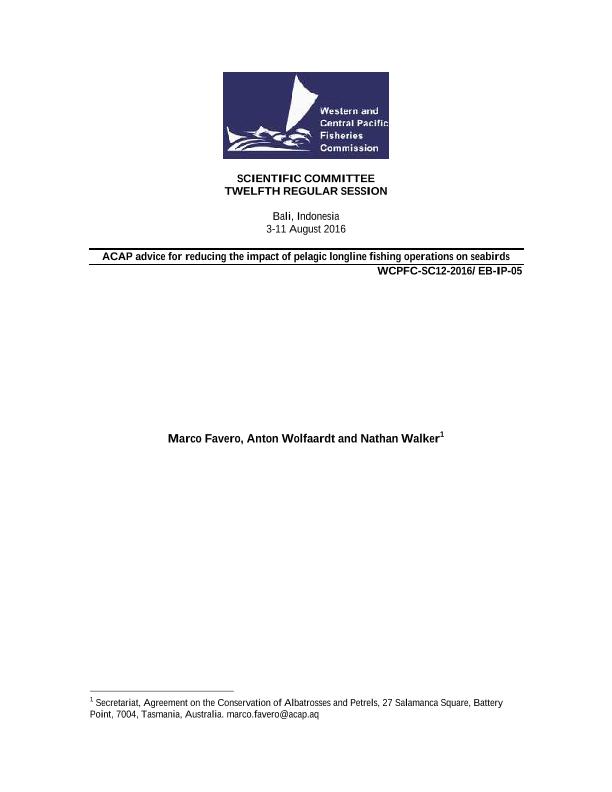Evento
ACAP advice for reducing the impact of pelagic longline fishing operations on seabirds
Tipo del evento:
Reunión
Nombre del evento:
12th Regular Session of the Scientific Committee
Fecha del evento:
03/08/2016
Institución Organizadora:
Western and Central Pacific Fisheries Commission;
Título de la revista:
12th Regular Session of the Scientific Committee
Editorial:
Western and Central Pacific Fisheries Commission
Idioma:
Inglés
Clasificación temática:
Resumen
The incidental mortality of seabirds, mostly albatrosses and petrels, in longline fisheries continues to be aserious global concern and was the major reason for the establishment of the Agreement on theConservation of Albatrosses and Petrels (ACAP). In longline fisheries seabirds are killed when theybecome hooked and drowned while foraging for baits on longline hooks as the gear is deployed. Theyalso can become hooked as the gear is hauled, although many of these seabirds can be released alive withcareful handling. ACAP routinely reviews the scientific literature regarding seabird bycatch mitigation infisheries, and on the basis of these reviews updates its best practice advice. The most recent review wasconducted in May 2016 at ACAP´s Seabird Bycatch Working Group and Advisory Committee meetings(ACAP 2016), and this document presents a distillation of that review for the consideration of theWCPFC Scientific Committee. A combination of weighted branch lines, bird scaring lines and nightsetting remains the best practice approach to mitigate seabird bycatch in pelagic longline fisheries.Changes in this regard only applied to the recommended minimum standards for line weighting regimes,now updated to the following configurations: (a) 40 g or greater attached within 0.5 m of the hook; or (b)60 g or greater attached within 1 m of the hook; or (c) 80 g or greater attached within 2 m of the hook. Inaddition, ACAP endorsed the inclusion in the list of best practice measures of two hook-shielding devicesas stand-alone mitigation measures. Such hook-shielding devices encase the point and barb of baitedhooks until a prescribed depth or time immersed to prevent seabird becoming hooked during line setting.The following performance requirements were used by ACAP to assess the efficacy of hook-shieldingdevices in reducing seabird bycatch: (a) the device shields the hook until a prescribed depth of 10 m orimmersion time of 10 minutes is reached; (b) the device meets current recommended minimum standardsfor branch line weighting; and (c) experimental research has been undertaken to allow assessment of theeffectiveness, efficiency and practicality of the technology against the ACAP best practice seabird bycatchmitigation criteria. ACAP recognizes that factors such as safety, practicality and the characteristics of thefishery should also be taken into account when considering the efficacy of seabird bycatch mitigationmeasures and consequently in the development of advice and guidelines on best practice.
Palabras clave:
Pelagic longline
,
Seabird bycatch
,
RFMOs
Archivos asociados
Licencia
Identificadores
Colecciones
Eventos(IIMYC)
Eventos de INSTITUTO DE INVESTIGACIONES MARINAS Y COSTERAS
Eventos de INSTITUTO DE INVESTIGACIONES MARINAS Y COSTERAS
Citación
ACAP advice for reducing the impact of pelagic longline fishing operations on seabirds; 12th Regular Session of the Scientific Committee; Pohnpei; Micronesia; 2016; 1-11
Compartir




